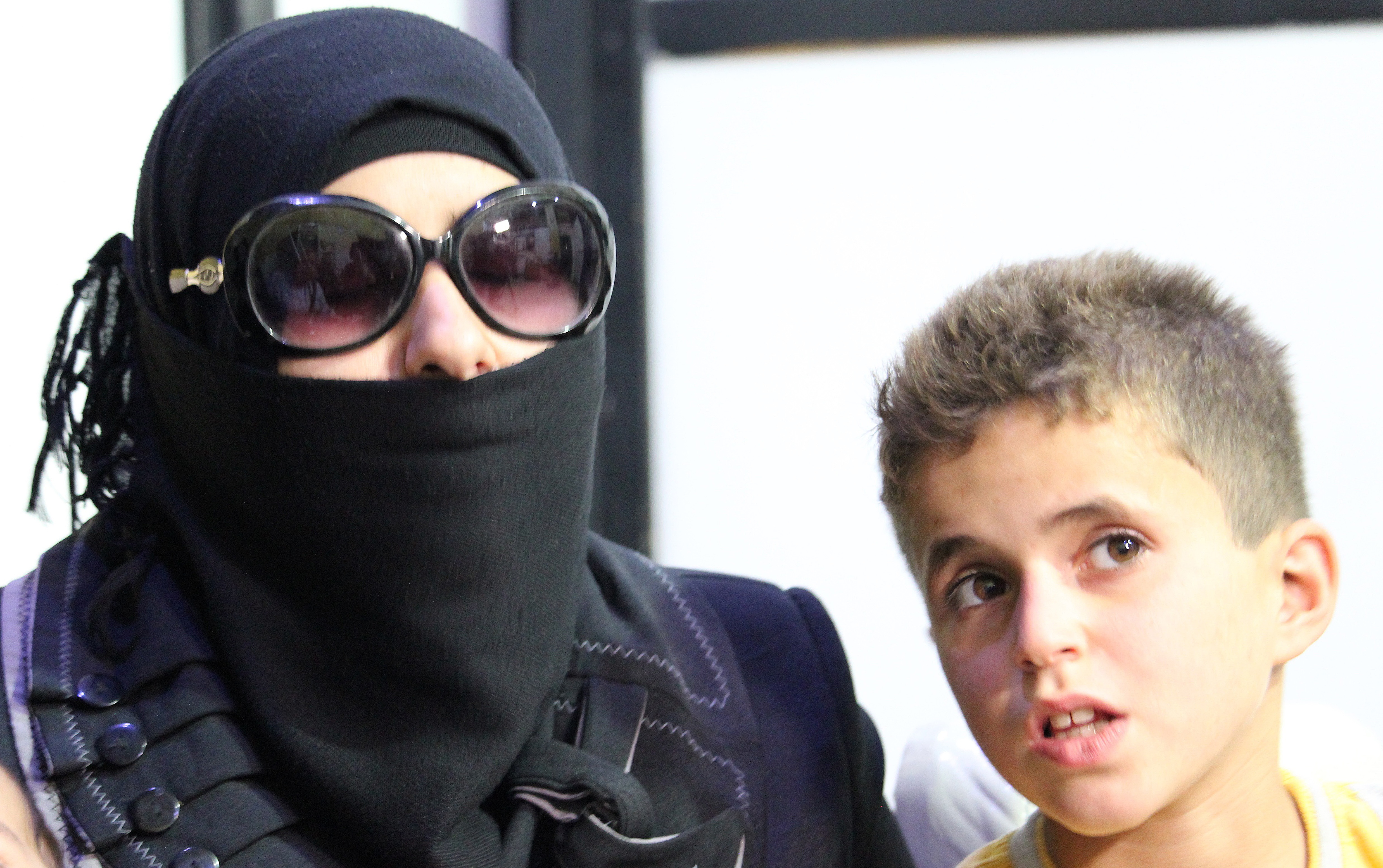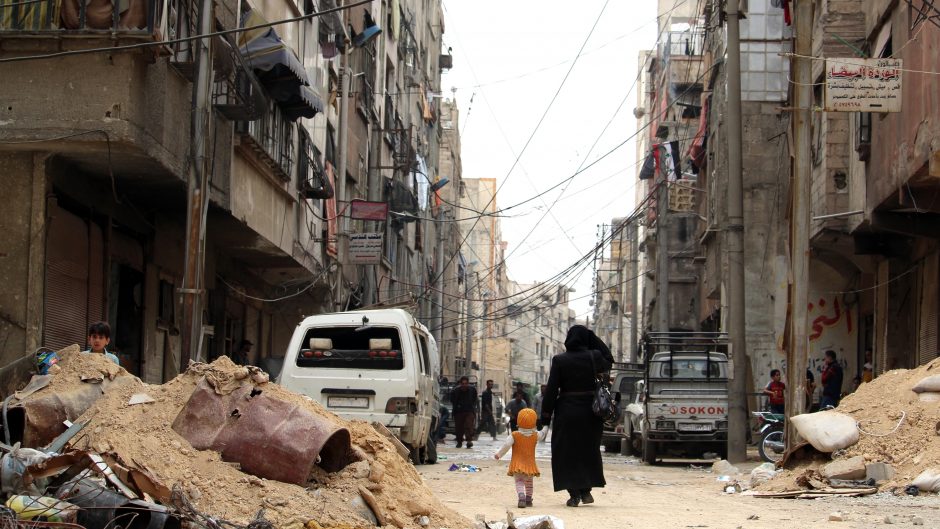May 30, 2018
One of the most startling sights upon entering the barren wasteland where the Syrian city of Douma used to be is the statue of a giant arm shooting out of the ground skyward, clutching a bunch of grapes.
It’s not clear if it managed to stand miraculously through the pounding the rebel-held enclave took during long years of siege, or if it was recently resurrected by the pro-Syrian government forces that retook the city in April after a ferocious air bombardment.
It’s certainly had a new paint job. A man with a hose stood dutifully spraying away at it in the middle of a traffic circle ringed by impossibly bent lampposts.
But the tragedy of that thrusting arm can be lost on no one — it's a symbol of the once-fertile region of East Ghouta, which encompasses Douma, now surrounded by scorched earth and a city laid to ruin.

“I talk with my God all day long,” said a woman who approached us in the street soon after we arrived. “In the afternoon, in the evening, in the middle of the night. For understanding.”
“What does your God say?” I asked. “He doesn’t answer,” she replied.
Our translator made a point of writing down the woman’s name. The Ministry of Information will want to know to whom we spoke.
It was with the Ministry of Information’s permission that we were in Douma in the first place. And the Ministry of Defence, which sent an army officer to escort us through the numerous checkpoints between Damascus and Douma, more of a suburb of the Syrian capital.
For the past seven years, the city has been synonymous with the Syrian opposition to President Bashar al-Assad.
The Douma of the here and now symbolizes Assad’s march towards victory in the civil war, employing the siege-starve-and-bomb tactics that worked for him in East Aleppo in 2016.
He didn’t do it on his own, of course. It is the Russian army that patrols the streets of Douma, its personnel carriers moving along in a lazy crawl with soldiers sitting on the back wearing guns and sunglasses.

With their help — and that of Iran and Hezbollah — Assad has managed to claw back control of most of the country, while the opposition has splintered into dozens of factions ranging from the Free Syrian Army to an array of jihadi groups.
But this victory has created a dilemma for the government. On the one hand, it wants to play down the alleged April 7 chemical weapons attack that many say prompted the mainly Islamist rebels left in Douma to capitulate.
On the other, it wants the world to see it is in control — and show off the network of tunnels it says the rebels built underneath the city, which the government believes reinforces its message that the opposition has been funded by countries such as Saudi Arabia and Qatar pursuing their own regional ambitions.
The tunnel entrance would be easy to miss — hidden under mounds of sandy earth, with corrugated iron sheets stuck in to stop it caving in – if it weren’t for the newly painted sign hung above it.
“Private Hospital of the Damascus Countryside,” it reads, looking rather prim amid the gargantuan destruction all around it. The name is flanked by Russian and Syrian flags.
The tunnel connects to the basement of the building next door, a former hospital that literally went underground and is still functioning today — although presumably with a change in management.
A medical student there recited the government line that there was no chemical attack on April 7. It was people suffering from asthma, he said, and too much dust from the tunnels.
Damascus has alternated between alleging the rebels staged the attack and that they faked it with the help of Western-backed opponents.
For Rasoon Masmoud, it is neither here nor there. She sat in the waiting room worried about her 10-year-old son, who she told us had stopped growing during five years under siege.
Masmoud is no fan of the rebels and, like many Syrians, calls them terrorists.
“When we tried to leave, we couldn’t, because the terrorists wouldn’t let anyone out,” she said. “When the army entered the city, they brought fruit and bread. Before that, a loaf of bread was a dream. We used to eat barley.”

The tunnels that wend their way beyond the waiting room descend 15 metres below ground, our soldier guide told us. The main one is well lit and wide enough to drive a truck through.
But smaller, narrower tunnels shoot off to the left and right in darkness, with small rooms here and there that our escort said were used by the rebels to keep and torture prisoners, or to store weapons.
They look a little like the set of an old Star Trek episode. Our translator announces she thinks the government will turn the tunnels into a tourist attraction one day.
Back above ground we asked to film the site of the alleged chemical attack that brought Douma back into the international spotlight in April, prompting the United States, France and Britain to green-light limited airstrikes against Syria.
But our minders had developed group amnesia. Even an Information Ministry employee who had taken journalists to the same place shortly after the alleged attack said he couldn’t remember where it was.
The people we did manage to meet seemed genuinely happy to see a foreign news crew in their midst. In a small souk struggling back to life, a man offered us some freshly made falafel.
Mohammed, a gaunt man claiming to own the only bicycle repair shop in town, said he stayed open throughout the fighting and kept his five children in the basement at night to keep them safe.
"I heard about that, but I didn’t smell anything,” he said when we asked about the chemical weapons.

Mohammed and his family are among some 50,000 people still left in the city. The rest have either boarded buses with rebels bound for the opposition territory in the north under the terms of their surrender, or gone to government-controlled refugee camps.
Foreign aid workers say Damascus is using them to screen people, looking for political opponents and young men who have avoided military service.
II.
The pitted decimation of Yarmouk looks even worse than Douma, if that’s possible — a marooned universe of blackened buildings staring at each other across a front line that feels as close together as two teeth.
There is hardly anyone left in Yarmouk, once home to 160,000 people, and lying just eight kilometres from the centre of Damascus — close enough for the rebels holding it to lob mortar shells into the centre of town.

After taking Douma, Assad’s forces turned to Yarmouk and other pockets on the city’s southern flank, Russian and Syrian war planes bombing it all day, every day. But it was also a battle that needed fighting on the ground.
We hadn’t been there more than 30 minutes before an armored personnel carrier careened around the corner, screaming on its treads.
A bunch of Syrian army soldiers jumped out with a wounded comrade bleeding from the stomach and hustled him into an ambulance.
Karam Daoud, who was in the same forward unit, said the injured man was hit by a sniper as he and others tried to enter a building occupied by ISIS fighters.
Daoud is in his early 20s and has already been in the army for seven years. There is gunfire and the sound of mortar shells landing all around, but he doesn’t flinch once. He said he’s lost his sense of fear.
There are some reminders, echoes of another, kinder life, tucked in between the cold concrete of Yarmouk. Under the arch of one building was a sort of rest station that looked like a kid’s clubhouse.
It had a sofa and pictures of fighting comrades, both dead and alive, hanging on the walls. And a bright orange rotary phone that actually rang.
Someone up the line was asking for water.

On one exposed stretch along the front, they’d hung a tin sheet as a blind against shooters, and someone had drawn a picture of Handala, a child refugee character recognizable by his spiky hair created by the now-deceased Palestinian cartoonist Naji al-Ali.
Before the war, Yarmouk was home to the largest Palestinian community in Syria, refugees from the 1948 Arab-Israeli war and their descendants.
When the uprising against the Syrian government began in 2011, rival Palestinian factions split. The FSA soon moved into the camp and so did the Islamist Jahbat al-Nusra, which was affiliated with al-Qaeda at the time. But by 2015, ISIS had taken complete control.
“For a long time around here, there was no Syrian army, only Palestinian groups,” a bearded Palestinian fighter named Abu Malik said.
“But [when] ISIS took control of this area, the [Syrian army] entered to support us.”
Abu Malik is a member of the Popular Front for the Liberation of Palestine - General Command (PFLP-GC), a proscribed group in Canada and other Western countries. It's just another example of the complicated lines that criss-cross the Middle East.
His house was on the ISIS-held side of Yarmouk, so his family lives in one of the pockmarked apartment blocks on the edge of the battle zone.

None of the Syrian army soldiers we spoke to expected the ISIS fighters to resign — and they didn’t want them to. ISIS had posted enough videos showing brutal executions of Syrian soldiers.
“We don’t expect them to go out,” Daoud said. “So we will kill them here.”
The Syrian government declared on May 21 that it had captured all of Yarmouk. News agencies reported that about 1,600 ISIS fighters and their families boarded buses bound for the last remaining strip ISIS still controls along Iraq's border with Iraq.
That has been the pattern following the negotiated surrender of various opposition groups, who are then taken mainly to Idlib, in the north.
The state-run news agency SANA denied the bus reports. The government did, however, claim victory, declaring the army in full control of all the territory in and around Damascus for the first time since the start of the rebellion.
That will offer them some breathing space. But while Assad and his allies may be in the ascendant in Syria’s internal conflict, the drumbeat of the ever-present prospect of a wider regional war has been beating louder of late.
Israel is active in the skies above Syria, striking at what it says are Iranian lines entrenched against it. Turkey is moving against Syrian Kurdish troops who seek to create their own territory along the Turkish border, while the U.S. is backing Kurds who fought ISIS further east.
Beyond all that, Assad presides over a ruined country and a diminished people, broken or displaced or dead.
The monuments to his leadership are the mountains of collapsed concrete that define towns like Douma. They seem taller even than the buildings they once were, and make the people trying to make their way amongst them appear miniature by comparison.
It is as good a metaphor as any: Humanity dwarfed by the atrocity of war.
